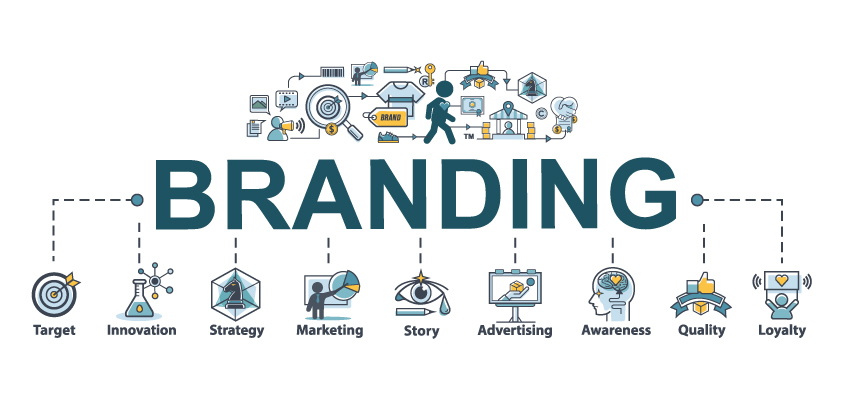How to Utilize Robust Branding for Sustainable Company Success
How to Utilize Robust Branding for Sustainable Company Success
Blog Article
Building Durable Branding for Long-Term Business Success
A cohesive brand identification not only differentiates a business from its competitors yet likewise cultivates trust fund and commitment among consumers. What techniques can companies use to not just develop an unforgettable brand name but additionally endure its importance over time?
Recognizing Brand Identification
Brand identification offers as the cornerstone of a firm's photo and reputation, encompassing elements such as logo design, color combination, typography, and messaging. Each component plays an essential role in producing a well-known and natural brand name that resonates with its target market. A properly designed logo design works as a graph of the brand's worths and goal, while a carefully selected color palette evokes certain emotions and associations.
Typography likewise contributes significantly to brand name identity; the choice of font style can influence understandings of imagination, reliability, or expertise. Uniformity in these elements promotes familiarity, allowing clients to promptly attach and recognize with the brand in numerous contexts.
Furthermore, messaging is just as important, as it interacts the brand name's core worths and differentiators. Clear and compelling messaging assists establish a strong narrative that engages consumers and builds trust.
Eventually, a distinct brand identification not only enhances exposure yet also fosters commitment amongst customers. By investing time and sources into creating a durable brand name identity, companies can create a long lasting impression that supports long-lasting development and success.
Value of Uniformity
Maintaining consistency across all brand name elements is vital for strengthening recognition and count on amongst consumers. A cohesive brand identity-- including logo, shade typography, scheme, and messaging-- produces a unified experience that customers can conveniently recognize. When these aspects are consistently applied throughout numerous platforms, from advertising and marketing products to social media, they enhance the brand's visibility and make it extra unforgettable.
Irregular branding can bring about complication and thin down brand name equity. It raises questions concerning reliability and authenticity when consumers run into variations in brand presentation (Robust Branding). This disparity can wear down trust fund, making it much less most likely that consumers will certainly select your brand over rivals
In addition, constant branding fosters customer loyalty. When consumers know what to anticipate from a brand, they are much more likely to develop a psychological connection, leading to repeat acquisitions and long-term connections.
To accomplish uniformity, businesses should create comprehensive brand name guidelines that outline the correct use of all brand components. Regular training for staff members and regular audits of advertising materials can aid guarantee adherence to these standards, eventually leading the way for sustained business success with a strong and reputable brand photo.

Crafting a Customer-Centric Experience
Developing a customer-centric experience is crucial for businesses aiming to foster strong partnerships with their clientele. This approach prioritizes understanding and satisfying the needs, choices, and assumptions of customers at every touchpoint. By actively listening to consumer comments and performing extensive marketing research, services can tailor their offerings and solutions to straighten more very closely with what their target market wishes.
Central to crafting a customer-centric experience is the personalization of communications. Robust Branding. Making use of data analytics allows business to section their client base and supply customized marketing company website solutions, products, and messages. This not just improves customer satisfaction but likewise drives commitment and encourages repeat service
Moreover, effective interaction plays an essential role in a customer-centric approach. Transparent and open dialogue cultivates depend on and enhances the bond in between the business and its consumers. Companies should ensure that their customer care groups are trained, understanding, and receptive, giving support that shows an understanding of private customer journeys.
Leveraging Digital Platforms
In today's electronic age, services should take advantage of the vast capacity of online systems to improve their branding initiatives and get in touch with consumers. These systems, that include social media sites, web sites, and e-commerce networks, give special opportunities for brands to involve with their target market in real-time, cultivating a sense of community and loyalty.
Social media site platforms such as Facebook, Instagram, and Twitter make it possible for brands to share their stories, values, and items while permitting for straight interaction with consumers. This two-way communication not only humanizes the brand yet additionally aids organizations collect beneficial understandings right into customer choices and worries. Furthermore, a strong on-line existence can enhance brand exposure and attract brand-new customers through natural reach and targeted marketing.
Furthermore, having a properly designed web site works as a main hub for brand name info, showcasing product or services while offering a smooth user experience. Shopping abilities further assist in direct sales, making certain a hassle-free buying experience for customers. By successfully leveraging these electronic platforms, services can build a durable brand identity that resonates with their target market, eventually contributing to long-term success and growth.
Determining Brand Name Success
Gauging brand name success is vital for organizations aiming to examine the effectiveness of their branding strategies and campaigns. This analysis enables organizations to understand how well their brand reverberates with target audiences and drives service objectives. Key performance signs (KPIs) such as brand awareness, client interaction, and commitment are crucial metrics to take into consideration.
Brand name view it now recognition can be gauged through Read Full Report studies, social media reach, and internet site web traffic analytics. High degrees of awareness indicate that consumers recognize and recall the brand, which is foundational for future investing in choices. Client interaction metrics, such as social media sites interactions and email open prices, provide understanding right into exactly how actively customers are taking part with the brand name.
Moreover, loyalty can be evaluated with metrics like Web Promoter Rating (NPS) and repeat acquisition prices. These indications expose not only consumer complete satisfaction but also the likelihood of customers suggesting the brand to others.
Verdict
A natural brand identity, defined by a memorable logo design, consistent color scheme, and thoughtful typography, promotes customer recognition and trust. Measuring brand name success through key performance indications lines up approaches with market requirements, ultimately driving sustained growth and durability in an affordable landscape.
A natural brand name identity not just distinguishes a business from its rivals however likewise cultivates trust fund and commitment amongst customers - Robust Branding. What methods can businesses employ to not just produce an unforgettable brand name however additionally suffer its significance over time?
By successfully leveraging these electronic systems, businesses can build a robust brand identity that reverberates with their target audience, inevitably adding to long-lasting success and growth.

Report this page